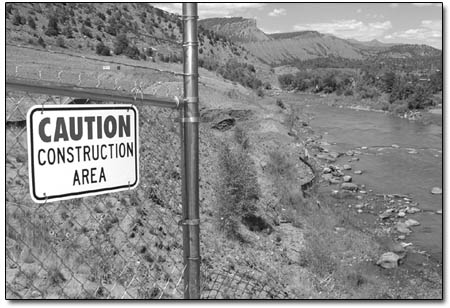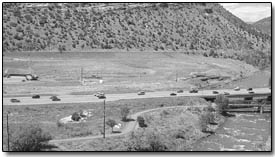 |
| Water flows down the Animas
River near Santa Rita Park on Monday, across from the future
site of the A-LP pumping station. The Citizens’ Progressive
Alliance has called for a formal investigation into project
cost overruns and what it says are other malfeasances on
the part of the Bureau of Reclamation, which is building
A-LP. /Photo by Todd Newcomer |
Charges of criminal activity are now being
leveled at the Animas-La Plata project. A group opposing the
ambitious water project has approached the Department of Interior
and requested an internal affairs investigation of the Bureau
of Reclamation, the agency responsible for the design and construction
of A-LP. Among the accusations are deliberate errors in anticipated
costs, lack of environmental review and consistent suppression
of the Freedom of Information Act.
According to the Bureau of Reclamation, the need for A-LP dates
back to 1868 when an agreement was struck to compensate Indian
tribes with water rights. In 1968, A-LP was first authorized
for construction by the U.S. Congress as a way of fulfilling
that century-old agreement to the Southern Ute and Ute Mountain
Ute tribes. At that time, the A-LP project was proposed as a
diversion of water from the Animas and La Plata rivers to a
series of reservoirs in order to serve the tribes’ irrigation
needs. However, courtesy of the Vietnam War, that project was
never built.
Since that time, the project has seen numerous challenges and
revisions. In 2000, a scaled-down version, coined “A-LP
Lite,” was authorized by Congress. The changed project
included a 120,000-acre-foot (more than 39-billion gallons)
reservoir 2.5 miles southwest of downtown Durango in Ridges
Basin. A pumping plant located near Smelter Rapid and Santa
Rita Park would siphon up to 280 cubic feet per second from
the Animas River and pump it uphill to feed the reservoir. Water
stored in the reservoir would no longer be used for agriculture
but would serve yet-to-be-determined municipal and industrial
needs in New Mexico and Colorado.
Construction on this project got under way early last summer
in Ridges Basin, and the reality of A-LP came to downtown Durango
early this summer with work on the pumping plant across the
river from Santa Rita Park. However, while many local residents
have begun to view the project as a done deal, many are continuing
to fight A-LP. One group, the Citizens’ Progressive Alliance,
is pursuing six separate lawsuits against the Department of
the Interior and the Animas-La Plata project. The most significant
of the CPA’s legal actions had a day in court Aug. 20
and alleges that the Bureau of Reclamation has failed to do
necessary upkeep on the A-LP water rights, also known as diligence,
and as a consequence, has lost them.
In addition to legal challenges, the CPA took its opposition
in a new direction last week. In a letter dated Aug. 29, 2003,
CPA Chair Phil Doe asked Ronald Gonzales, a special agent with
the Department of the Interior’s Office of Inspector General,
to begin an independent inquiry into A-LP.
Steve Cone, the CPA’s A-LP project coordinator and board
member, explained, “My understanding is that Phil (Doe)
has been in touch with Ronald Gonzales, and we are hopeful he
will raise issues before the inspector general that we feel
are of great concern and worthy of some serious scrutiny on
his part.”
The first concern raised in the letter deals with cost overruns
associated with A-LP. In a July 31 letter to its partners, the
Bureau of Reclamation explained that the original cost estimates
of $337.9 million were dramatically low. New estimates had risen
to $500 million, a jump of nearly $163 million, or 50 percent.
The CPA charged that this radical underestimation was a deliberate
attempt to squeeze the controversial A-LP project into existence.
Cone remarked: “Our view is that the initial cost estimates
were purposely and monstrously low-balled simply to rally public
opinion and get the shovels in the ground. The Bureau of Reclamation
never came clean and has still not come clean on the real costs
of this project.”
Cone also cited previous settlement costs to the tune of $165
million that were involved with the first incarnation of the
project. He said this sum has not been factored into current
estimates and is effectively being hidden from taxpayers.
Another of the CPA’s grievances is the failure by the
Bureau of Reclamation to conduct environmental mitigation. Specifically,
the group charges that a wetlands mitigation plan has never
been completed, largely because there is no La Plata River water
available to create wetlands.
“There exists at this point no environmental commitment
plan for the project that requires that the bureau mitigates
for impacts,” Cone said. “If they have a plan, they
haven’t released it to the public.”
Doe’s letter also charges that the Department of Interior
has repeatedly refused to respond to the CPA’s Freedom
of Information Act requests and consistently placed them on
the back burner.
 |
| Construction of the pumping
plant has proceeded according to schedule according to Pat
Schumacher, ALP projects manager. In late July, the Bureau
of Reclamation announced that it had underestimated the
total project’s cost by 50 percent. /Photo by Todd
Newcomer |
“Just the other day, I had a call from the Department
of Interior about a request made in December of 2000 that has
still not been processed,” Cone said. “We’ve
seen a huge reluctance to process public requests that would
reveal the bureau’s rationale.”
Cone said that the overall intent of the call for an inquiry
is to uncover the hidden realities of the A-LP project so the
public can make informed decisions. “We look at the Inspector
General’s Office as a means of bring this out so that
people can take a closer look at the project’s problems,”
Cone said. “Whether a department with the charge of policing
the Bureau of Reclamation will actually do that remains to be
seen.”
Pat Schumacher, the Bureau of Reclamation’s projects
manager for A-LP, countered that his agency has always been
above board about the project and has nothing to hide. To this
end, he referenced the revelation of the project’s radically
underestimated costs. Instead of trying to hide these shortfalls,
Schumacher said the Bureau of Reclamation went out of its way
to make them public.
“I think just the opposite,” he said. “As
soon as we knew about it, we put the whole thing out to our
sponsors and the public.”
He added that the net effect of the shortfalls will likely
be an extension of timeline beyond the targeted completion date
of spring 2008. “We budget and request funds from Congress
every year,” Schumacher said. “What this will do
is extend the need to seek funding further down the road.”
As for work to date, Schumacher said that crews have taken
the money that’s been awarded to the project and put it
to good use. “For the money we’ve gotten to date,
we’ve done really well,” he said.
However, the CPA contends that the money A-LP has gotten to
date has been effectively stolen from taxpayers. In sum, the
CPA charges that since 1968, A-LP has created a “recipe
for abuse” that may constitute criminal behavior. Noting
a direct implication in Doe’s letter of “criminal
action,” Cone said, “I think the language couches
any direct accusations of criminal action. I think any careful
inquiry into the action of Bureau of Reclamation personnel would
be a real eye opener for the public and lead to further investigations.”
Now that the letter has been delivered to Gonzales’ office,
Cone said the ball is in the inspector general’s court.
Whether an official inquiry into the internal goings on of the
Animas-La Plata project will take place should be known in the
near future.

